By Dennis Reilly
In part 1 of this series I discussed markings on helmets and bunker gear that can help in accounting for members operating at an emergency. In part 2 we’ll look at items that can be added to self-contained breathing apparatus (SCBA) to support accountability on the emergency scene. Before I dive into the subject let me make a disclaimer: there are those in the fire service that will raise the liability issue with some of items I suggest. I am not a lawyer nor an SCBA manufacturer. If these issues are of concern, then I recommend that you pursue them with your legal council or your SCBA supplier. From my standpoint, firefighter safety trumps all other concerns. If I can add features to an SCBA that will not hinder its operations and that can enhance my ability to account for my members during an emergency, then I will take those steps. If you are not comfortable with my suggestions, don’t follow them—that simple.
RELATED FIREFIGHTER TRAINING
Accountability: Positions in the System
Accountability: Keeping the Perspective
Functional Fireground Accountability, Part 1 | Part 2: Tools and Technologies
I don’t recommend any particular product. The pictures included in this article are simply the products I have used in the past and do not constitute an endorsement of any one item. There are many vendors in this market so you will have a range of items from which to choose. Circling back to the previous point, if there was such an issue with liability, why are there so many vendors selling these products? Why has a regulatory agency not taken steps to remove these type items from distribution?
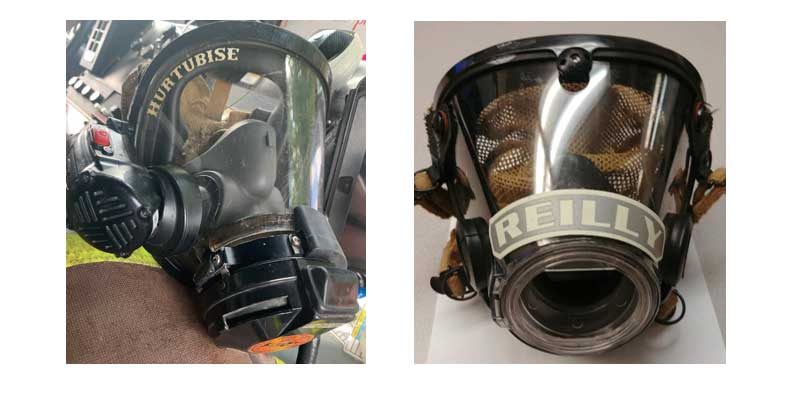
The first item is a face piece identification label, which allow you to place the individual member’s name on their face piece. Some of these decals come with reflective lettering. These not only help during an emergency or Mayday situation; they can be very helpful during normal operations in limited visibility environments. They do not hinder one’s vision and are applied to the exterior of the face piece. These duplicate some of the information I recommend on helmet shields and might seem somewhat redundant. I have seen firefighters lose their helmets at an emergency, so having a back up is not a bad thing. When I was working overseas, I often heard former special operations folks say: “One means two.” Redundancy merely gives us a better chance at being able to account for our members.
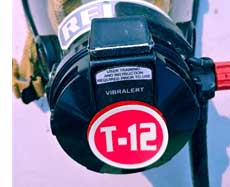
The next item that can be beneficial is a company identifier for the mask mounter regulator (MMR). These are reflective decals that can be applied to the exterior of the MMR and identify which company/apparatus the SCBA came from. Coupled with the face piece labels, these allow you to identify a member by name and their company/apparatus assignment. Like the name labels, these decals are reflective, so their utility extends beyond a Mayday situation. I cannot count the number of times I have had trouble identifying a member in a smoke-charged environment and I would have been thankful for anything that could have made my life easier.
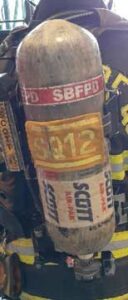
An SCBA equipped with a company identifier and the cylinder is labeled with a department identifier. 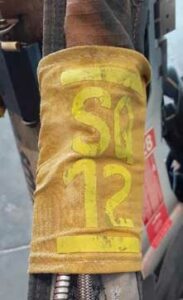
The SCBA shoulder strap identifier that matches the cylinder retaining band identifier. 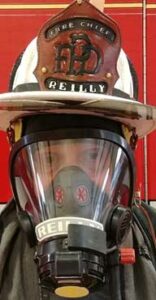
This picture shows both SCBA markings and a helmet shield with the member’s name and organization. 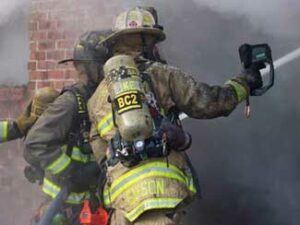
SCBA and bunker coat marking at a working fire. The picture clearly shows how easy it is to identify a member using these items. (Photo courtesy Curt Isakson)
Next are what I refer to as company identifying bands. These can be added to the cylinder retaining strap and shoulder strap of the SCBA. In conjunction with putting the member’s name and department on the back of the coats, these bands make for rapid identification of a firefighter and their unit assignment. These can be purchased in a variety of colors which allows for color coding by company type. In a previous organization, we marked our engine companies with white letters on a black band, our rescue company with white letters on a blue band, and chief officers with lime letters on a white band. Like all the other items I have discussed, it did not take long for even the naysayers to comment on how useful the new marking system proved to be. The last item you should consider is marking your SCBA cylinders with a department identifier. This could be a decal with your logo or simply putting an abbreviation on the cylinder. This is very helpful in auto/mutual aid situations. It is well within the realm of possibility to have more than one E-1 on an emergency scene if multiple agencies normally respond together.
All the items I have discussed in this series are inexpensive, easy to apply and implement, and easy to interpret. Adding items to both bunker and SCBA that do not compromise the performance of the equipment and enhance the incident commander‘s ability to account for the members operating at an emergency are worth consideration. The worst-case scenario will always happen at the worst time and bring confusion into an already complex situation. Being able to account for the members operating at a scene will be of the utmost importance. Adding tools to the accountability toolbox can give you the small but critical advantage you need to be successful in managing the event.
Dennis Reilly is a 44-year veteran of the fire service and is currently the fire chief in Pittsburg, Kansas. Prior to moving to Kansas, he was the fire chief in Sunrise Beach, Missouri, and he is a retired battalion chief with the Cherry Hill (NJ) Fire Department. He was one of the original members of the New Jersey Urban Search & Rescue Task Force 1 and deployed to Ground Zero on 9/11. He holds an Master of Public Administration degree from Penn State and is a Chief Fire Officer. In addition to his fire service career, he is a combat veteran of the U.S. Army and worked as a private security contractor in Iraq and Afghanistan.

